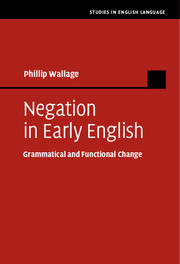Book contents
- Frontmatter
- Dedication
- Contents
- List of figures
- List of tables
- Acknowledgements
- Abbreviations
- 1 Introduction
- 2 Quantitative Evidence for a Model of the Jespersen Cycle in Middle English
- 3 Distributional Evidence for Two Types of ne: Redundant Negation
- 4 Distributional Evidence for Different Types of not
- 5 The Syntax of the Early English Jespersen Cycle: A Morphosyntactic Feature-based Account
- 6 The Role of Functional Change in the Jespersen Cycle
- 7 Negative Concord in Early English
- 8 Negative Inversion: Evidence for a Quantifier Cycle in Early English
- 9 The Loss of Negative Concord: Interaction Between the Quantifier Cycle and the Jespersen Cycle
- 10 Conclusion
- References
- Index of names
- Index of subjects
7 - Negative Concord in Early English
Published online by Cambridge University Press: 13 July 2017
- Frontmatter
- Dedication
- Contents
- List of figures
- List of tables
- Acknowledgements
- Abbreviations
- 1 Introduction
- 2 Quantitative Evidence for a Model of the Jespersen Cycle in Middle English
- 3 Distributional Evidence for Two Types of ne: Redundant Negation
- 4 Distributional Evidence for Different Types of not
- 5 The Syntax of the Early English Jespersen Cycle: A Morphosyntactic Feature-based Account
- 6 The Role of Functional Change in the Jespersen Cycle
- 7 Negative Concord in Early English
- 8 Negative Inversion: Evidence for a Quantifier Cycle in Early English
- 9 The Loss of Negative Concord: Interaction Between the Quantifier Cycle and the Jespersen Cycle
- 10 Conclusion
- References
- Index of names
- Index of subjects
Summary
Introduction
The following three chapters examine the distribution of early English negative concord in diachronic corpus data. This chapter provides an overview of early English negative concord. Negative concord is not a homogenous phenomenon in early English – there is both diachronic and diatopic variation in the types of negative concord employed. Giannakidou (2000, 2006) identifies two parameters of negative words in negative concord languages: their negativity – whether or not negative words contribute negative force at LF, and their quantificational force – whether they are universal quantifiers, existential quantifiers or indefinites. I argue that, in order to derive the patterns of negative concord we find in early English and the changes in their availability over time, negative arguments and adverbials vary in precisely these two properties.
Van der Wouden (1994) distinguishes two types of negative concord: negative doubling involves concord between a negative marker and one or more negative words, as in (144); negative spread involves concord between two or more negative words but no negative marker, as in (145).
(144) Ic ne funde nanne gylt on him
I NEG found no sin in him
‘I found no sin in him’ (cowsgosp,Jn_[WSCp]:19.6.7261)
(145) no man seyd no-thyng a-gens hem
no man said nothing against him
‘no man said anything against him’ (CMKEMPE,33.730)
Chapters 8 and 9 investigate the relationship between negative doubling and the model of the Jespersen Cycle I proposed in Chapters 2–6. The relationship between negative doubling and the Jespersen Cycle is not a straightforward one. In Old English and Early Middle English, almost all clauses with negative words exhibit negative doubling with ne – the pattern illustrated by (144). However, at stages three and four of the Jespersen Cycle, the negative marker not does not take over from ne in negative doubling contexts in the way that it does in sentential negation contexts. Instead, negative doubling begins to be lost. Consequently, the use of negative doubling duringME becomes variable. Chapter 9 argues that variability between PDE no-negation (146a) and not-negation (146b) originates in the interplay between the loss of negative concord and the Jespersen Cycle duringME and persists unchanged into Present-day English.
- Type
- Chapter
- Information
- Negation in Early EnglishGrammatical and Functional Change, pp. 148 - 159Publisher: Cambridge University PressPrint publication year: 2017

